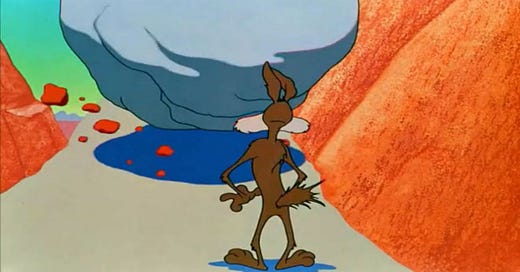Here’s a scary thought for a Friday afternoon: What if reality simply doesn’t make sense, and never will? Characters (and by extension their writers) must sometimes grapple with an absurd, unknowable and indifferent universe.
Jack Gross rounds up some examples of existential absurdism in film:
“Camus posits that absurdist art cannot attempt to present viewers with concrete meaning or answers, because there are none. Instead, art must restrain itself from grandiose attempts at presenting answers and must teach us not to desire reason but to come to terms with its absence.”
Aperture cuts together a primer on existentialism: an opposing force to nihilism where humans must generate their own meaning in a meaningless universe (instead of succumbing to despair). David Robson looks at two opposing responses to existential dread: creative action to reduce the fear, or conspiratorial thinking that deepens it.1
So where can we see this on screen?
Sophia sees a path to create our own structure and meaning in the way Ghost Dog: Way of the Samurai shows a character immersing himself in the code laid out in the Hagakure.
The Fiction Addiction puts forward Surf’s Up as a kid-friendly take on living authentically and creating your own meaning for life.
Aamatullah Rajkotwala explores how Everything Everywhere All At Once dramatizes the different paths to confronting an absurd world.
Stef and Terrence at Quality Culture dig in to how Nope shows characters turning the absurd and unexplainable into spectacle as a way to confront it.
After you watch David Cronenberg’s short Camera (featured above), take a look at the breakdown from Acolytes of Horror on how the deceptively simple film creates a creeping sense of existential dread.
👋 Are you new here?
Inneresting is a weekly newsletter about writing and things that are interesting to writers. Subscribe now to get more Inneresting things sent to your inbox.
Previously on Inneresting…
In case you missed it, last issue’s most clicked links Anil Dash outlines systems of power including a look at how the ultra-wealthy think about money, and what corporate boards actually do.
What else is inneresting?
Parker Molloy on the shift in reporting in the New York Times, sacrificing journalistic practices and creating false equivalences in pursuit of controversy.
Danny Boyd compares the cinematography of Alien to The Knick and Gimme Shelter, and finds the connections are more than celluloid-deep.
Derek Taylor from The Pudding takes us through the reclassification of climate zones for 70 major cities due to a warming planet. For example: Cities like Austin and Los Angeles in the year 2070 would be classified with Arid climate cities like present-day New Delhi.
And that’s what’s inneresting this week!
Inneresting is edited by Chris Csont, with contributions from readers like you and the entire Quote-Unquote team.
Are you enjoying this newsletter?
📧 Forward it to a friend and suggest they check it out.
🔗 Share a link to this post on social media.
🗣 Have ideas for future topics (or just want to say hello)? Reach out to Chris via email at inneresting@johnaugust.com, Mastodon @ccsont@mastodon.art, or Bluesky @ccsont.bsky.social
Post-Credits Scene
Editor’s Note: For more on conspiratorial thinking, see Issue 208!




